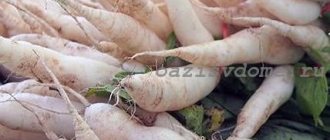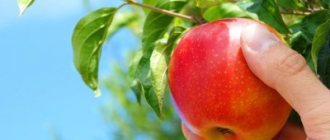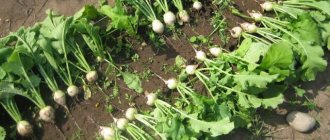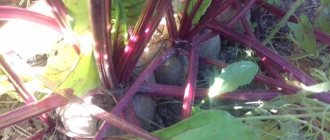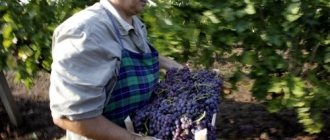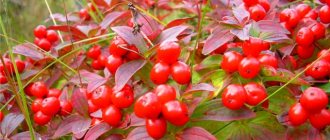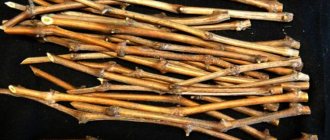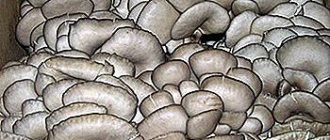Signs of maturity
The most important indicators for determining the moment of picking berries are:
- Its sugar content.
- Acidity.
The industrial maturity of grapes differs from the technical condition of the fruit. This means that the fruits contain as much sugar, acids and other substances as needed to produce the desired type of wine (table or dessert). Technical maturity is determined by the results of chemical analysis.
In addition to this indicator, it is important to distinguish between the full and physiological maturity of the fruit. When the fruit is fully ripe, the level of sugar and acids stabilizes for a certain period, mainly for several days.
When to collect Isabella
It is also necessary to take into account that the time for harvesting grapes of the same variety in different climatic zones can vary significantly.
In the temperate latitudes of Russia, which have more or less suitable climatic conditions for growing grapes, the Isabella variety has become widespread. Frost-resistant, undemanding to watering and fertilizers, to chemical protection from diseases and pests, it grows, giving a bountiful harvest. He grows, forgiving even the absolute inattention of his owner. And this, you see, is a very tempting characteristic for someone who chooses an unpretentious variety.
So, Isabella is harvested for making wine in the same year with a spread of up to forty days in different regions of our country. Still, it does not have time to ripen everywhere. Because grapes are now grown even in Siberia! Not Isabella, of course, but still. Twenty years ago this was considered impossible in principle. But that’s not about that now.
Isabella grapes belong to the table-technical variety. It is known to be used both for food and for making wine. In addition to examining the appearance and tasting, to determine the ripeness of Isabella, you must certainly smell the bunch. When fully ripe, the berries emit a characteristic aroma characteristic of this variety.
Preserving the yeast
Beginners in winemaking use traditional recipes to make wine using wild yeast. Colonies of microorganisms “live” in abundance on the surface of grapes. To start the natural fermentation process, it is necessary that such “savages” get into the wort. Otherwise, the sugar contained in the berries will not ferment entirely or will not ferment at all. For this reason, grapes are not washed before processing. If the berries are very dirty, wipe them with a dry cloth.
To preserve the greatest amount of wild yeast, during the grape harvest, winemakers advise following simple recommendations:
- There is no need to pick bunches of berries immediately after rain, or for three days after it. This is explained by the fact that most of the yeast is washed away by streams of water, and it takes time for those that remain alive to reproduce. If there was a lot of rain in the summer and you cannot find the best time to harvest grapes, you need to make a homemade starter in advance, which can support fermentation in the future.
- Winemakers do not advise cutting fruits early in the morning while there is still dew, as well as at night when it has already fallen, and during fog. In addition to the fact that excess moisture has a detrimental effect on the condition of the yeast, it also spoils the taste of the future wine or champagne, making it watery. When grapes are cut at the wrong time, putrefactive processes are activated already in the warmth. If a bunch contains grapes affected by rot, they can infect all their neighbors in a short period.
- The harvest of grapes, which were grown for the preparation of wine drinks, is carried out by cutting off the bunches with scissors or pruners. At this stage, it is important not to damage the plaque on the fruit. To avoid this, the bunches are held by the stem.
- To minimize damage to the grapes after the bunch is cut, they are placed in flat containers for safe transportation. The use of buckets and similar containers is not recommended.
Features of harvesting some varieties
How to properly harvest grapes for wine? The bunches should be cut carefully so as not to damage the yeast coating. Each bunch is held from below so as not to crush the berries. Special tools are used for the process: garden shears, sharp pruners.
Isabel
Harvest time also depends on the specific plant variety. Isabella is characterized by increased productivity, while not being afraid of frost, resistant to many diseases and pest attacks.
The variety is considered quite unpretentious; it does not require special attention, which undoubtedly attracts many gardeners. Isabella is a table grape that people prefer to consume not only fresh, but also to make homemade wine from it.
When is the best time to harvest Isabella grapes to make homemade wine? Depending on the place of growth, Isabella is collected with a spread of 30-40 days.
Southerners begin collecting at the end of September, residents of the middle zone - from early to mid-October. Some gardeners leave the bunches until November so that they become full of sweet juice. But it’s important to get there before the first frost.
When can Isabella grapes be cut for wine? The degree of maturation is determined not only by appearance. Winemakers know that berries can be picked when the characteristic berry aroma appears.
Cabernet
When to harvest Cabernet grapes for wine? Technical varieties, which include Cabernet, are harvested at temperatures not lower than 16 degrees and not higher than 20 degrees.
Some wines are made from berries that have reached their technical maturity before the onset of frost. However, it should be borne in mind that frozen green berries should not be used as wine material.
Technical varieties are harvested completely and do not leave any unripe berries on the vines. As soon as the level of acidity and sugar content reaches the required parameters, the entire crop is cut.
On a note! If affected by parasites or disease, only healthy berries should be selected.
Wine material for Icewine
For a special wine, special grapes are used. Icewine is an “ice wine” made from fruits that were picked after frost.
Winemakers take a big risk by leaving brushes on the vines. Frosts must come sharply; only under this condition can the berries be used to make Icewine. As a rule, in our climate there is a long off-season, during which the crop may die.
If winemakers have obtained the necessary raw materials for Icewine, they will receive a unique alcoholic product. It is valued all over the world for its originality and uniqueness.
Lydia
Many gardeners grow Lydia grapes. The wine it produces is aromatic, tasty, with original strawberry notes. The “Lydia” grape differs from other varieties with its original taste. The main advantage of “Lydia” is considered to be the ripening time – about 160 days.
When to harvest Lydia grapes for wine? Most often this is mid-October. It is in mid-autumn that the berries are filled with juice with the desired acidity and sugar content. The fruits are not harvested early in the morning when dew falls.
How many days after the rain can you harvest grapes for wine? You should wait at least 2-3 days, and only then start collecting. Immediately before harvesting, all work on the ground stops so as not to stain the bunches. After all, it is known that fruits are not washed before making wine.
Deadlines
The time for harvesting grapes depends on many nuances: the grape variety and the type of processing, climatic conditions, etc. Depending on the ripening period, varieties are of early, middle and late ripening.
The grape harvest begins with early grape varieties - “white feteasca”, “pinot” group. They accumulate more than 17% sugar in their composition by the first half of September. Then the harvest of medium-ripening grapes is carried out - “Aligote”, “Riesling”, etc. The fruit processing season ends with the harvest of late varieties - “Cabernet Sauvignon”, “Saperavi”, etc.
In most cases, the grape harvest begins with white varieties, from which light wine materials are produced, which are used in the creation of table and champagne wines.
Climatic conditions have a great influence on determining the timing of fruit ripening. The difference in ripening time for the same grape variety depends on the ambient temperature and humidity level.
In fact, the grape harvest is a holiday whose history goes back to Ancient Rome. The celebration in honor of the future harvest was accompanied by squeezing out juice accompanied by songs and dances. In Russia, there are 3 harvest festivals - Nut, Honey and Apple Spas.
How to help grapes ripen
If the appearance of the bunches indicates that they will not ripen before the cold weather, you should help it reach the desired condition. To do this, remove the leaves that block the sun for those clusters that are still ripening, stop watering and fertilizing. This will speed up the ripening process.
From the above it follows that harvesting grapes is a very responsible and painstaking undertaking. Late harvesting, as well as premature harvesting, leads to the fact that part of the bunches will be irretrievably lost. And this is very unpleasant, especially when you expect excellent results.
Therefore, how and when the harvest will take place must be thought out in advance. It is also necessary to take a responsible approach to choosing the method of harvesting berries; this will also affect the quality and quantity.
Harvesting Rules
To get a high-quality harvest, you should know how to cut fruits correctly:
- Too early in the morning and rainy weather are considered unsuitable times for harvesting.
- The work is carried out in several stages, as the brushes mature. To obtain accurate results, a hydrometer is used to measure the amount of sugar. This process is troublesome, but pays off with the high quality of the harvest.
- Farmers advise harvesting berries in the pre-lunch hours, when there is no dew on the clusters.
- If there are a lot of rotten berries in the bunches, the harvest time is slightly accelerated. Rotten berries can not only affect the quality of the product, but also cause all sorts of diseases in the wine drink.
- When the harvest is completed, it is imperative to inspect the grape bushes, discarding rotten and still green fruits.
A simple step-by-step recipe for grape wine
To prepare 5 liters of wine, we will need:
- grapes – 7 kg;
- sugar – 50-100 g per 1 liter of juice obtained.
Accordingly, if you want to make more wine, then simply multiply the amount of grapes used proportionally: for 10 liters you will need about 14 kg of grapes, etc.
The recipe itself is divided into several stages.
Stage I
We sort through the grapes: remove large debris, twigs, etc. Next, we carefully press them: using a special press, or with our hands.
Transfer the resulting mass (pulp) into a large container. We fill the container no more than ¾ of the total volume. Fermentation containers made of food-grade plastic or glass are ideal. Cover the wort with a clean cloth and leave for 3-4 days in a warm place for fermentation. Stir the wort with a glass or plastic spoon 2 times a day.
It is better to avoid any contact of the wort with metal.
This can cause oxidation and spoil the taste of the future wine. Stage II
After 3-4 days, the active fermentation phase will begin. The pulp will begin to foam and float. Our task is to remove the cap from the foam and strain the wort. The hat can be removed directly by hand. In order not to lose the product, place it in gauze and squeeze out the juice thoroughly.
After we have dealt with the head, we need to filter the wort from other smaller residues. We do this in any convenient way: through gauze or (which is more convenient) using a special overflow siphon with a filter.
Stage III
Pour the grape juice into a clean container. It can be used in a large glass bottle or plastic container. We close the container with a water seal and put it away for fermentation at a temperature:
- 18-22°C – for light grape varieties;
- 20-28°C – for dark grape varieties.
Some recipes suggest using a regular glove instead of a water seal, but this is not entirely correct. The glove creates pressure inside the container, as a result of which the juice is saturated with carbon dioxide, which affects the final taste of the drink. Experienced winemakers recommend using only water-based water seals.
Stage IV
In 3 days we can take the first samples. If the drink is sour, add sugar - 50 g per 1 liter of wort. We do this as follows: mix sugar with a small amount of juice in a separate container, heat the mixture over low heat and stir it constantly until the sugar dissolves in it. Then pour the sweet syrup into the main wort.
After 3-4 days we taste the drink again. If the acid still appears, repeat the procedure. We can do this up to 4 times until we achieve the desired sweetness and fermentation ends.
Fermentation lasts on average 3 weeks. After the expiration date, pour the wine from the sediment into separate clean, washed bottles and tightly cap them. The wine will mature in them for several more months. The minimum waiting period is 40-60 days.
Attention! If fermentation has not stopped 50 days after installing the water seal, you need to pour the wort without sediment into another clean container to avoid the appearance of bitterness. Then put it under a water seal to ferment under the same temperature conditions.
Stage V
When the water seal stops working (blowing bubbles or the glove is deflated), and the wort has become clearer and sediment has appeared at the bottom, you need to drain the new wine. This is necessary so that the dead yeast at the bottom does not spoil the aroma and taste of the wine.
Pour carefully so as not to pick up any sediment. It is best to use an overflow siphon or, in extreme cases, a regular hose.
Stage VI
After draining, you need to decide on the sweetness of the wine - add sugar. Since active fermentation has ended, sugar will not turn into alcohol. You should add sugar based on your taste preferences, but not more than 250 g per 1 liter.
If you are already satisfied with the sweetness, you don’t need to add anything additional.
Stage VII
The last stage involves maturation, during which the wine acquires its final taste. The stage lasts from 40 to 380 days.
Place the container with wine under a water seal (if it was sweetened), or simply close it with a tight lid. Should be stored in a dark place at a temperature of 5-16°C.
Hand harvesting only
To ensure that the grapes have integrity and an attractive appearance when harvesting, special technical means are used. Clusters are cut manually using garden pruners, scissors or a sharp knife. Hand-harvested crops are rarely damaged. This method allows simultaneous sorting of bunches according to external characteristics. The use of technical mechanisms for harvesting grapes (see photo below) damages part of the harvest.
Combine harvesting experience
The experience of the farm has shown that grape bushes formed according to the Guyot system most fully meet the requirements of harvesting with a combine. This occurs mainly due to the fact that during the formation of Guyot, the fruiting zone is located predominantly at the same level of the trellis height, and is not scattered vertically, as is the case with the horizontal boundary (control). This feature of the formation, in addition to increasing the productivity of the machines and the quality of the grape harvest, allows the farm to save on the periodic replacement of half of the combine shakers (crushing working bodies) - the amount of annual savings is about 450 thousand rubles. Vertical management of bush growth makes it possible to use machine harvesting of most technical grape varieties, even without preliminary chasing of shoots. The cost of harvesting grapes with a combine is 140 rubles/t, which is half the cost of manual harvesting.
In the photo: harvesting grapes with a combine harvester
In addition to the successfully chosen formation of bushes for use in the vineyard of a combine harvester, the design features of the trellis and the materials from which it is made are of great importance.
Experience in using mechanized grape harvesting on the farm has shown that the most convenient for harvesting grapes with a combine are trellises, the basis of which is intermediate and end supports made of galvanized steel in accordance with European standards. Reinforced concrete columns, which are common in industrial vineyards in Russia, are destroyed by the crushing elements of the combine harvester (shakers). Destructions shorten the service life of reinforced concrete supports - they need to be renewed frequently. Wooden supports, regardless of the type of wood and the type of antiseptic used for impregnation, turned out to be short-lived and required frequent replacement.
Due to the fact that the width of the iron supports is almost half that of wood and reinforced concrete (only 56-63 mm), more complete shaking off of berries is achieved in their area, and accordingly, the quality of harvesting is improved.
Video: Harvesting grapes with a combine harvester
Harvest conservation measures
If the autumn is rainy, some farmers use completely new equipment to eliminate the effects of the rain as much as possible. To prevent the fruits from swelling from excess moisture and the valuable juice from becoming watery, the ground is covered with a thick plastic film. Other companies try to reduce wateriness through artificial dehydration.
Still others, before sending the fruits to be crushed, spray them with hot air, which dries the outer surface of the grapes well. An interesting fact is that the owners dried the berries, wet after the rain, using a helicopter that circled over the grape plantings at low altitude for two hours.
Illegally harvested harvest
If the grapes are harvested early, the wine will be produced at low speed and with a sharp, even unpleasant acidity, which tastes reminiscent of the acidity of unripe grapes. When fruits are harvested later than the required time, they will have increased sugar content and low acidity. The must from such grapes in most cases does not mature. If you manage to start fermentation, the result is a strong and heavy table wine.
When the wine does not ferment due to the fact that the grapes contain excess sugar after harvest, the drink is susceptible to various diseases. With a favorable harvest time and good care of the fruit, such wines can ferment in the spring of next year when the weather warms up. This significantly extends the time required to fully prepare the drink, increases the financial costs of caring for the grapes after harvest, and increases the cost of production in general.
The use of technical tools significantly speeds up harvesting, but a certain percentage of the crop suffers from mechanical damage. To reduce the risk of berry rotting, it is important to check and sort literally the entire crop. Varieties that ripen on the bushes longer than usual are cut last, when the sugar content in the fruits is maximum.
Sweet or sour
The berries should not be too overripe, but it is also not recommended to pick unripe fruits. The location where the vines grow is of great importance. Residents of countries with hot, dry climates more often drink light, weak wines with a low degree, made from table varieties.
The alcohol content will depend on what grapes were used: sweet varieties produce stronger wines. The more sugar in berry juice, the higher the strength of the wine. Since southerners do not like strong wines, they begin harvesting without waiting for full ripeness.
On a note! Bunches that have just begun to ripen, but have not yet reached full ripeness, are considered “technically” mature. “Technical” ripeness is characterized by certain indicators of sweetness and acidity of the berries.
Sweet and semi-sweet wines are made from grapes at the peak of ripening.
When to pick grapes for wine in the middle zone? It is important to harvest on time, since the berries quickly overripe, and the necessary acid is lost. If there is not enough sugar in the berries, granulated sugar is added during the process, but fruit acids cannot be replaced with anything.
How to determine when to harvest grapes? Professionals use special instruments to take measurements to determine the acidity and sweetness in berries. The following method is recommended for home winemakers:
- 2-3 weeks before the time when you plan to pick berries, taste the fruits collected from different vines every day.
- When the sweetness becomes constant, without increasing, the taste of the pulp and juice is not too pungent, and the acidity is falling, it is time to harvest.
- The appearance of the berries is also an indicator of ripeness. In white varieties, the berries will become transparent and the skin will become thin. Blue grapes can be harvested for wine if the color of the fruit becomes rich and the skin darkens.
